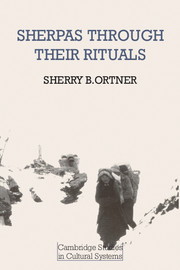Book contents
- Frontmatter
- Contents
- Preface
- 1 Introduction: some notes on ritual
- 2 The surface contours of the Sherpa world
- 3 Nyungne: problems of marriage, family, and asceticism
- 4 Hospitality: problems of exchange, status, and authority
- 5 Exorcisms: problems of wealth, pollution, and reincarnation
- 6 Offering rituals: problems of religion, anger, and social cooperation
- 7 Conclusions: Buddhism and society
- Notes
- Bibliography
- Index
2 - The surface contours of the Sherpa world
Published online by Cambridge University Press: 05 June 2012
- Frontmatter
- Contents
- Preface
- 1 Introduction: some notes on ritual
- 2 The surface contours of the Sherpa world
- 3 Nyungne: problems of marriage, family, and asceticism
- 4 Hospitality: problems of exchange, status, and authority
- 5 Exorcisms: problems of wealth, pollution, and reincarnation
- 6 Offering rituals: problems of religion, anger, and social cooperation
- 7 Conclusions: Buddhism and society
- Notes
- Bibliography
- Index
Summary
Nepal is certainly one of the more romanticized places on earth, with its towering Himalayas, its abominable snowmen, and its musically named capital, Kathmandu, a symbol of all those faraway places the imperial imagination dreamt about. And the Sherpa people, the subject of this book, are perhaps one of the more romanticized people of the world, renowned for their mountaineering feats, and found congenial by Westerners for their warm, friendly, strong, self-confident style.
What there is about the Sherpa world that conduces to such a style is probably impossible to isolate, although it has variously been attributed to their glorious mountain environment, their Buddhist religion, or, by the Sherpas themselves, to the especially pure water found exclusively in the Sherpa region. In any case, in buoyant, outgoing social style as well as in robust physical type, they resemble their own racial, cultural, linguistic, and religious cousins the Tibetans, and differ substantially in both style and physique from the South Asians and the Chinese, the two major groups that bracket the greater Tibetan culture area.
It has been fairly well established that the Sherpas migrated into their present location in Nepal from the Khams region of eastern Tibet about 450 years ago. It is not clear why they left; harrassment by marauding Mongol tribes, or religious persecution by the reformed Tibetan Buddhist sect have been suggested, although it seems equally plausible that there was some local upheaval in the feudal social structure.
- Type
- Chapter
- Information
- Sherpas through their Rituals , pp. 10 - 32Publisher: Cambridge University PressPrint publication year: 1978



